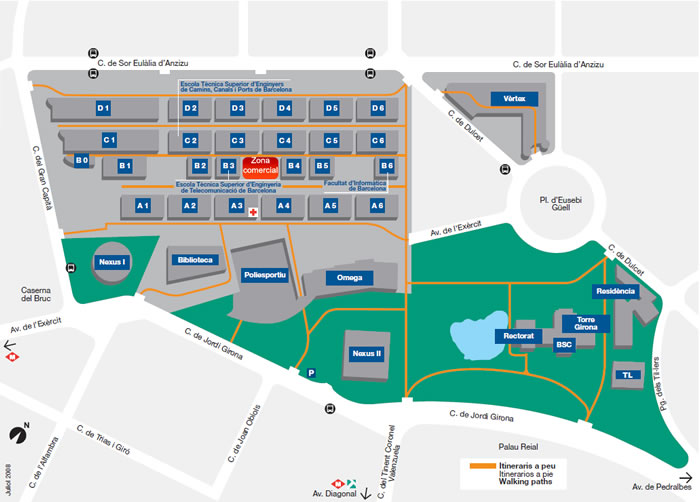3rd International BSC Doctoral Symposium 2016
Fecha: 22/Mar/2016 Time: 09:00 - 06/May/2016 Time: 19:00
4th, 5th and 6th May 2016
Meeting Room: Aula Master
Building: A3, Campus Nord, C/ Jordi Girona 1-3
E-08034 Barcelona
How to arrive?
See a map of all the public transport available and get some indications below:
By Metro/Subway/Underground
The nearest stations are "Palau Reial" and "Zona Unversitaria" (L3 or Green Line). You will have a 7-minutes walking distance to arrive to the meeting. Check maps, timetables and fares in Transports Metropolitans de Barcelona.
By Bus
Different bus lines arrive near the meeting place, see the map above.
Check maps, timetables and fares in Transports Metropolitans de Barcelona.
By Tram
The tram station more near is "Palau Reial". Obtain more information on times and fares, we recommend visiting the website www.tram.cat.
By Train
The train station more near is Barcelona Sants and from this station you will have to take the L3 or Green Line in direction to “Zona Universitaria” and drop in the “Palau Reial” or "Zona Unversitaria" stations.
To get more information on times and fares, we recommend visiting the website Renfe Cercanías Barcelona.


Target group: Postdoctoral researchers and Postgraduate Students
Primary tabs
Programme & Training
The full program will be available for download here as a pdf after the selection of talks. Please see the outline below.
The training seats are limited and will be assigned on a first come, first served basisand Volunteers and Presenters will have preference. The participants accepted to join the training will be notified before 24th April and will be asked to confirm their attendance.
| Day 1 (4th May) | |||
| Start time | Activity | Speaker/s | Chair |
| 8.30 h Registration | |||
| 9.00h | Welcome and opening |
Mateo Valero, BSC Director | Maria Ribera Sancho |
| 9.20h | Keynote talk: Big Data for the Study of Climate Change and Air Quality | Francisco Doblas Reyes, Head of Earth Sci Department, BSC |
|
| Abstract: The extraction of a significant message oriented towards the action of a range of users based on the large set of heterogeneous data that the weather, climate and air quality communities produces and has produced is the main challenge of Big Data for these communities. The kind of problems to deal with include the operational nature of many of the activities, which implies sharing the data with very strict schedules, the need to extract information from large heterogeneous datasets by users that in some cases are not aware of the limitations of those data (uncertainty level, covariances, etc), or also the management of large datasets with high levels of documentation, curation and long-term availability. These communities are also special in that they are highly organised and collaborative worldwide and have a strong statistical background, substantial distributed computational power. This presentation will address these characteristics and illustrate them with recent examples. | |||
| 10.20h Event Photo | |||
| Coffee break & First Poster Session: Algorithms and Models | |||
| 10.40h | Development of a wind energy climate service based on seasonal climate prediction, Veronica Torralba, Earth Science, BSC Assessment of Meteorological Models for Air Pollution Transport: Analysis between Mexico and Puebla Metropolitan Areas, Sergio Natan González Rocha, Earth Science, BSC - UV Enhanced Monte Carlo methods for Sparse Approximate Matrix Inversion, Oscar Esquivel Flores, ITESM & Diego Davila, Computer Science, BSC/ UPC Dynamic Load Balancing for hybrid applications, Marta Garcia Gasulla, Computer Science, BSC Effects of detailed ventricular anatomy on the blood flow, Federica Sacco, DTIC, Universitat Pompeu Fabra |
|
|
| First Talk Session: Post Doc research |
|||
| 11.30h | Probabilistic seismic risk assessment using CRISIS2015 & USERISK2015. Application to buildings of Barcelona, Spain. | Armando Aguilar, CASE, BSC |
|
| 11.50h | DimLightSim: Optical/Electrical Network Simulator for HPC Applications | Hugo Daniel Mayer, Computer Sci., BSC |
|
| 12:10h | Comparing electoral campaigns by analysing online data | Javier Espinosa, Computer Sci., BSC |
|
| 12.30h | Integrated approach to assignment, scheduling and routing problems | Laura Hervet- Escobar, ITESM |
|
| 12.50h Lunch break |
|||
| 14.00h | Tutorial 1: Algorithms and Techniques for Data and Computationally Intensive Problems | ||
Abstract: This tutorial will focus on key research methods, algorithms and techniques for Data and Compute intensive problems, ranging from theory creating and theory testing approaches to conceptual-analytical approaches and experimental ones that are able to lead to discovering global properties on data as well as providing efficient ways of parallel computation. These will be mainly deterministic and hybrid (stochastic/deterministic) methods and algorithms including:
|
|||
| 16.00h Coffee break |
|||
| Tutorial 1 continues | |||
| 18.00h | Adjourn |
||
| Day 2 (5th May) | |||||
| Start time | Activity | Speaker/s | Chair | ||
| 9.00h | Opening of the second day | ||||
| Second Talk Session: Algorithms, Numerical Methods & Data Science |
|||||
| 9.10h | Innovative algorithm for particles transport in a fluid | Edgar Olivares Mañas, CASE, BSC | |
||
| 9.30h | Validating the Reliability of WCET Estimates with MBPTA | Suzana Milutinovic, Computer Science, BSC | |||
| 9.50h | Efficient and versatile data analytics for deep networks | Jonatan Moreno, Computer Science, BSC | |||
| 10.10h | Numbering along advection for Gauss-Seidel and Bidiagonal preconditioners | Paula Córdoba Pañella, CASE, BSC | |||
| Coffee break & Second Poster Session: Simulations and Modelling | |||||
| 10.30h | Exploring the protonation properties of photosynthetic phycobiliprotein pigments frommolecular modelling and spectral line shapes, Marina Corbella Morató, Computational Biology, UB Clustering the Roman Empire: the use of multivariable analysis to understand cultural dynamics, Maria Coto-Sarmiento, CASE, BSC - UB Assessing drug-protein binding by simulation of stereoselective energy transfer dynamics: electronic interactions between tryptophan and flurbiprofen, Silvana De Souza Pinheiro, Computational Biology, UB Extrapolations of the fusion performance in JET, Dani Gallart Escolà, CASE, BSC Regional Arctic sea ice predictability and prediction on seasonal to inter-annual timescales , Rubén Cruz García, Earth Science, BSC |
|
|||
| Third Talk Session: Life Sciences |
|||||
| 11.20h | Identification of genetic variants associated with risk for a variety of cancers through the re-analysis of publicly available genome-wide data from more than 20,000 individuals | Marta Guindo, Life Sciences, BSC | |||
| 11.40h | Genomic Instability Promoted by Expression of Human Transposase-Derived Gene |
Elias Rodríguez Fos, Life Sciences, BSC | |||
| 12.00h | SMuFin2: Identification of virus in Cancer genomes using an improved version of SMuFin. | Mercè Planas-Fèlix, Life Sciences, BSC | |||
| 12.20h | Docking through Democracy Re-ranking protein-protein decoys with a voting system | Didier Barradas-Bautista, Life Sciences, BSC | |||
| 12.30h Lunch break |
|||||
| 14.00h | Tutorial 2: Scientific Visualisation of Data |
||||
| Abstract: Data visualization has become more important than ever in almost every discipline dealing with data. From creating a visual representation of data points as part of a research experiment, for showcasing progress, or for analysing 3D models, data visualizations are a critical and a valuable tool for gaining insight about data. When it comes to big data, weak tools with basic features get to their limits. In consequence, specific techniques should be developed and applied. This tutorial will address different techniques for visualizing big data collections. It will include an overview of the visualization process as a complex and greedy task and then it will discuss out of the box solutions that can help to analyse and interpret big data in aggregated and analytic ways. The tutorial will have a strong hands-on component for experimenting with the visualization of data collections of different types. | |||||
| 16.00h Coffee break |
|||||
| Tutorial 2 continues | |||||
| 18.00h | End of the Training and Adjourn |
||||
| Day 3 (6th May) | |||
| Start time | Activity | Speaker/s | Chair |
| 8.50h | Opening of the third day | ||
| Fourth Talk Session: Simulations and Modelling |
|||
| 9.00h | Block-Based Execution on an Integrated Vector-Scalar In-Order Core | Milan Stanic, Computer Science, BSC | |
| 9.20h | Photoprotection and triplet energy transfer in higher plants: the role of electronic and nuclear fluctuations | Lorenzo Cupellini, University of Pisa | |
| 9.40h | Modelling the Co-evolution of Trade and Culture | Simon Carrignon, CASE, BSC-UPF | |
| 10.00h | Simulating Gravitational Collapse with Arbitrary-Precision Arithmetic | Daniel Santos-Oliván, GWART, Institute of Space Science | |
| 10.20h | Crowd Simulation and Visualization | Hugo Perez, Computer Science, BSC | |
| Coffee break & Third Poster Session : Computer Science & Applications | |||
| 10.40h | Reproducing crowd turbulence with Verlet integration and agent modeling, Albert Gutierrez-Milla, Dani Gallart Escolà, CASE, BSC Generation of a simulation scenario from medical data: Carto and MRI, Mariña López-Yunta, CASE, BSC How Can We improve Energy Efficiency through User-directed Vectorization and Task-based Parallelization? HelenaCaminal, Computer Science, BSC Using Graph Partitioning to Accelerate Task-Based Parallel Applications, Isaac Sánchez Barrera , Computer Science, BSC Improving Scalability of Task-Based Programs, Iulian Valentin Brumar , Computer Science, BSC |
|
|
| Fifth Talk Session: Life Sciences |
|||
| 11.30h | Conserved differences in protein sequence determine the human pathogenicity of Ebolaviruses | Morena Pappalardo, Biosciences, University of Kent | |
| 11.50h | Enrichment of Virtual Screening results using induced-fit techniques | Jelisa Iglesias, Life Sciences, BSC | |
| 12.10h | On the way to real time protein-ligand sampling | Daniel Lecina Casas, Life Sciences, BSC | |
| 12.30h | PMut2: a web-based tool for predicting pathological mutations on proteins | Víctor López Ferrando, Life Sciences, BSC | |
| 12.50h Lunch break | |||
| 13.50h Visit to MareNostrum III (14.00 in Torre Girona) | |||
| Sixth Talk Session: Performance |
|||
| 14.40h | The OmpSs Reductions Model and How to Deal with Scatter-Updates | Jan Ciesko, Computer Science, BSC | |
| 15.00h | Per-Task Energy Metering and Accounting in the Multicore Era | Qixiao Liu, Computer Science, BSC | |
| 15.20h | Task Dependences Management Hardware Acceleration for Task-based Dataflow Programming models | Xubin Tan, Computer Science, BSC | |
| 15.40h | Runtime Estimation of Performance–Power in CMPs under QoS Constraints | Rajiv Nishtala, Computer Science, BSC | |
| Coffee break & Fourth Poster Session: Life Science Applications | |||
| 16.00h | Conformational landscape of small ligands: A Multilevel strategy to determine the conformational penalty of bioactive ligands, Toni Viayna Gaza, Facultat de Farmàcia i Ciències de l’Alimentació, Santa Coloma de Gramanet, UB Characteritzation of Protein-Protein Interfaces and Identification of Transient Cavities for its Modulation, Mireia Rosell Oliveras, Life Sciences, BSC Improvement of Protein-Ligand Binding Affinity Prediction using Machine Learning Techniques, Gabriela Hernandez Larios , Life Sciences, BSC - EM-DMKM Towards accurate solvation free energies of large biological systems, Sonia Romero Téllez , Departament de Fisicoquímica, UB |
|
|
| 16.40h | Conclusions | Maria Ribera Sancho |
|
| 17.30h | End of the Doctoral Symposium |
||


